


1872
Mary Jane Kerr
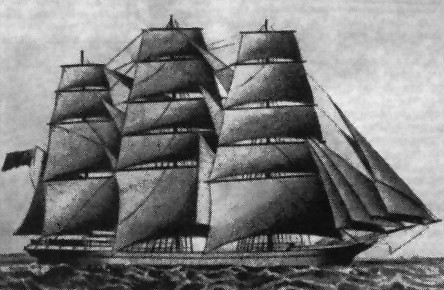
"City of Auckland"




|
The ship the City of Auckland was especially built for the London-Auckland trade. She was a composite vessel, having iron framing, sheathed with 5½ inch teak, copper fastened throughout. She was specially finely fitted up. On a scroll at the break of the poop were carved the lines by Campbell: Her home is on the deep. |
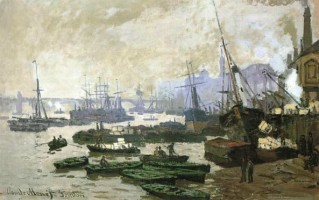 London, England |
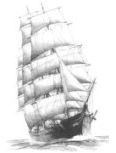
|
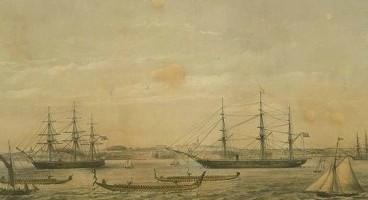 Auckland Harbour, New Zealand |
|
The City of Auckland No. 60.964, was a full-rigged ship, of composite build, of 780 tons register, built at Sunderland in 1869, and her dimensions were: length 172.2 feet, beam 33.1 feet, depth 19.1 feet. She had sailed from London on July 13, with a general cargo consigned to the New Zealand Shipping Company, at Napier. On January 24, 1871, the ship caught fire at Auckland, and when other methods to quell the fire failed, she was taken cut into the stream and scuttled, being refloated two days later. Later, she sailed from London on 31st May 1872 and arrived in Auckland on 3rd September 1872. The captain was William Ashby and the tonnage was 779. On board was Mary Kerr, who was met by her brother Richard and taken to Shortland (now part of Thames). Mary had given her age as 20, although she was only 16. After landing, all passengers were taken to the Immigration (Albert) Barracks. |
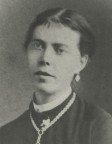 Mary Jane Kerr |

|
This fine clipper ship, and regular trader to this port, under the command of our old and esteemed friend, Captain Ashby, anchored outside the North Head shortly after noon, yesterday, after a splendid passage of 88 days from the Channel, and 85 from land to land, being again the fastest passage of the season. From the report given below it will be seen that the vessel had very pleasant weather throughout, and the voyage has been a most prosperous one, the only circumstance in any way tending to cast a shadow over the passage being the unfortunate death of the chief mate, who was drowned under circumstances as detailed below. Considering the large number of passengers, there has been but little sickness during the voyage, no deaths among the passengers; but four births. Immediately on the signal of "a ship inside Tiri Tiri" being run up at the flagstaff, Mount Victoria, speculation ran rife as to whether it would prove to be the well-known and favourite City of Auckland, or the long-expected, and apparently neever-to-arrive ship Bulwark, now long overdue, being six months out of London. Although the ship may now be looked for hourly, the chances were in favour of the City, all things considered; and so it turned out to be, for that vessel's number was run up shortly before noon, and at the same time the flag for the Health Officer was displayed. The reporters of the morning papers were the first to arrive alongside the vessel, and the Health Officer not arriving until nearly an hour afterwards, in consequence of the small crew (two men) who had to pull the heavy water policew boat against the wind and tide, a distance of nearly three miles. Several other boats afterwards arrived alongside the ship, but no person was allowed to board but the Health Officer. The male emigrants thronged the bulwarks, rigging and forepart of the ship, while the single women - apparently a very superior class of immigrants - dressed in their gayest attire, were congregated on the poop and eagerly scanned all approaching boats with the natural curiousity of their sex. On ascending the ship's side the Health Officer was loudly cheered by the passengers - a fine healthy looking lot of people - and kindly welcomed by Captain and Mrs. Ashby. He then commenced to make a minute examination of the passengers and crew. This threatening to be a long job, the several boats waiting round the ship set sail for Auckland again, none of their occupants having been able to obtain a footing on board the "City". The reporters' parcels were, however, lowered into the respective boats, by permission of the Health Officer and Pilot. About four o'clock the doctor had completed his survey, and gave the ship a clean bill of health, when the anchor was weighed, and the "City" came up the harbour, and anchored off the Queen-street wharf. The vessel arrives in her usual clean and orderly condition, and the whole of the passengers speak in terms of the highest praise of the kindness and attention which they have received from Captain and Mrs.Ashby. The City brings five cabin passengers, 14 third-class (paid), and 242 Government immigrants, also 650 tons of cargo. We think Captain Ashby has great reason to be proud of the performance of his noble ship, which has already become identified with this port, and we congratulate him and all concerned on the rapid and happy termination of the voyage. We have been kindly furnished by the Captain with the following particulars of the ship's progress since leaving London:- 29th May, 1872, left the East India Docks, with five chief cabin passengers, 14 third-class paid passengers, and 242 adults, Government immingrants, in all 321 souls, and 650 tons of general cargo; Doctor J. Waugh, Surgeon of the Royal Navy of H.M. Ships Challenger and Virago, medical officer on board. 31st of May the ship left Gravesend for Auckland, with light northerly winds and fine weather. 3rd of June, landed the pilot off Dartmouth; cleared the channel the next day, 4th. 14th, got the north-east trades in lat. 27.30° and long. 23° west. 17th, entered the tropics in 24° west. 22nd, lost the trades in 9.26° north and 25° west. 29th, got the south-eat trades in 4° north and 18° west. 2nd July, crossed the equator 26.13° west. 12th, sailed out of the tropics in 37.50°, and lost the trades the next day. 24th, passed the meridian of Greenwich in 38° south, and that of the Cape of Good Hope on 1st August. 19th, passed the meridian of Cape Leuwin. 25th, rounded Van Dieman's Land in lat. 45° south, 82 days from the Channel. 31st, sighted Cape Maria Van Dieman, New Zealand, 88 days from the Channel. Had light variable winds and fine weather through the Channel, and very good N.E. trades while they lasted. Between the N.E. and S.E. trades, light southerly winds, with a strong current setting to the N.W. for some days, during which time very little progress was made to the south. The S.E. trades proved squally and unsteady, and hanging far to the south, which drove us 38° west longitude. Between the meridian of Greenwich and the Cape of Good Hope, experienced a succession of strong south-east winds, which were foul, with heavy head-swell. Cape of Good Hope to Van Dieman's Land, fould winds between north and west, with a deal of damp, wet weather, during which time the ship made some excellent runs, one week 1750 miles, and another 1778; the two best days' run during the voyage, were one day 331 miles, and the other 310 miles. Our easting was run down between 44° and 45° south. From Van Dieman's Land to New Zealand, fresh S.S.E. winds, and wet squally weather, until we sighted the coast of New Zealand on Saturday, August 31, 92 days from Gravesend. September 1, lay becalmed in sight of North Cape. September 2, light north-east winds, which brought us into port. On the 10th of June, when 200 miles north of Madeira, Mr. Robert Milne, chief officer, who had been in the ship three voyages, and a first-rate officer, went over the side for the purpose of looking at the mizen rigging, and his foot slipped and he fell into the sea; wind moderate and weather fine at the time. The life-boat was lowered, and the body was picked up when just sinking, although it was only an interval of twelve minutes from the time the first alarm was given. He was brought on board, and notwithstanding all that medical skill could do, he never recovered. I was given to understand he could not swim. He was thirty-eight years of age, a native of Bauff, in Scotland. He leaves a widow and three young children. A collection was made for the same on board to the amount of twenty-one pounds and one shilling. The City of Auckland left London a new ship, on her first voyage to Auckland, on 19th of October, 1869. Since then she has made four successful voyages to Auckland from London, in two years two months and 21 days, having made the last return voyage to AUckland in seven months and 14 days - distance sailed on the last round, 30,212 miles. We have had four births, and no deaths. We have had very little sickness, considering the number of people on board, and the continuance of hot weather whilst running down our easting, and till we sighted the New Zealand coast. The following births occurred on the voyage:- June 4, Mrs. Sarah Ann Pearce of a daughter; June 9, Mrs. Sarah Jane Wood of a son; August 8, Mrs. Mary Brooking of a son; August 28, Mrs. Thomas Drowick of a son. The following flattering testimonial was presented by the passengers:- "Ship City of Auckland, August 31, 1872. - Dear Captain Ashby, - We, the undersigned, cannot part company with you and Mrs. Ashby without unanimously offering you our sincere gratitude for all your courtesy and kindness that you have invariably shown to us through all the trying circumstances of this long sea voyage. We earnestly hope that it may please God to bless and prosper you both wherever you are, and in all you do; and on your return home, if you do retire from your sea life, we trust that you will both live to enjoy many years of the rest and happiness that you have so deservedly earned. Believe us to remain, yours, etc., Rev. F.C. Lloyd, and all the cabin passengers." Captain Ashby made the following reply:- "To the Rev. F.C. Lloyd and saloon passengers on board the ship City of Auckland, September 2, 1872. I beg to thank you for the very flattering testimonial you have presented me with on our arrival, and accept it as evidence of your good feelings towards Mrs. Ashby and myself. Permit me, in tendering my best thanks for my wife and myself, to wish you every happiness and prosperity in the land of your adoption. - I remain yours, etc., William Ashby." Vessels spoken by the City of Auckland:- June 13th, lat.30.9° N., long. 20.45°, ship John Duthie, of Aberdeen, from London, bound to Sydney, out 14 days. June 25th, lat. 8.30° N., long. 24.22° W. put letters for England on board ship, Carnarvonshire, from Rangoon, bound to Cork, out 107 days. |
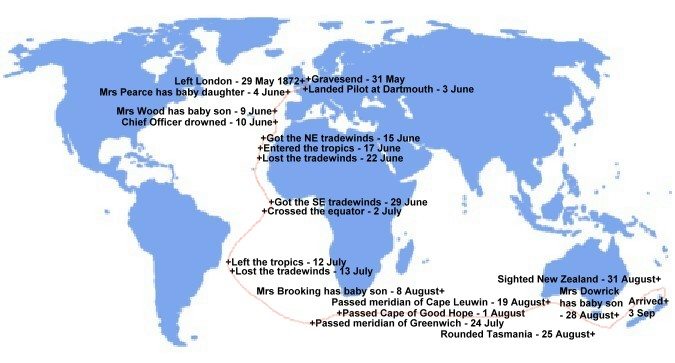

|
During the morning the signal was run up "a sail in sight"; this was afterwards changed to a ship... Shortly before one o'clock the numbers of the "City" were run up at the signal station... She came up towards the harbour under a crowd of canvas, before a gentle nor'-easter. The fact that there were on board the City of Auckland no less than 321 passengers, caused no little excitement, as a great number of these are coming out to join their friends who are already colonized. She does not bring many saloon passengers, as by recent legislation a vessel carrying a certain number of emigrants is compelled to devote her poop deck to the single women as a promenade... It seems remarkable that she has just traversed the globe in a little over seven months, one of which was passed in the port of London. This speaks well for the indomitable perserverance of her commander and part owner, Captain William Ashby. As we remarked the City of Auckland passed Deal on the 1st of June; passed Torbay on the 3rd, thus making the passage in 89 days... At a little after one a signal was transmitted for the Health Officer, and that functionary (Dr. Philson) on being sent for at once proceeded to the Wynyard pier where the police boat was in waiting to take him down. The vessel in the meantime anchored outside the Heads until Dr. Philson had made his inspection. With such a large number of passengers there is no doubt that this will take some hours... Three cases of gastric fever occurred during the voyage, the last case being a week ago... |

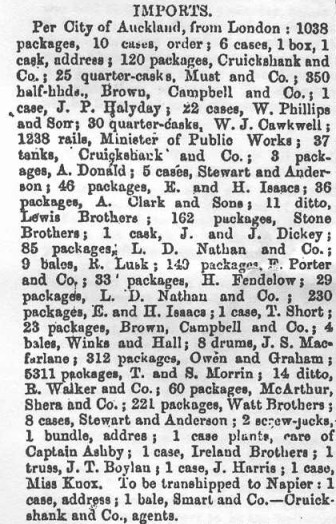 |
The NZ Herald of 4 September 1872, gave a listing of supplies brought in the City of Auckland's cargo. |

|
Click here for the "City of Auckland" Passenger List |

|
At the time of the casualty, a north-west gale was blowing and the weather was very thick, causing the master to mistake Kapiti Island for Stephen's Island, and alter the ship's course so as to run through Cook Strait. The ship was under topsails when she struck close to the wreck of the"Felixstone". She had on board 256 immigrants and had nearly completed her voyage from London to Napier. A certain amount of panic ensued among the passengers, but this was promptly quelled by the master, who revolver in hand, threatened to shoot the first person rushing the boats. The following morning, all hands were landed in perfect safety, a line being attached to the stern of each boat and slackened oft as it progressed towards the shore. In this way they were kept fore and aft and prevented from broaching to and capsizing in the heavy surf running. The English settlers and Maoris from Otaki rendered yeoman service in assisting the passengers shore, and afterwards were most liberal in their hospitality to the shipwrecked complement. The immigrants were forced to tramp to Waikanae, about 12 miles further south, to board the Government steamer Hinemoa which conveyed them first to Wellington, and then to Napier. From the first, it was apparent that the City of Auckland would become a total wreck, as very soon her, sternpost and forefoot gave way in consequence of the sea breaking against her, and she had also buried herself in the sand to a depth of eight feet. At the Court of Inquiry, the nautical assessors disagreed, and the chairman later gave an independent decision, in which he stated that though there was an error of 14 to 15 miles in the course marked on the chart, negligence could not be proved against any officer, and all certificates were returned. The ship was commanded by Captain George Ralls. |

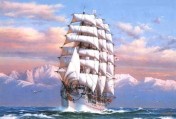 |
Return to Kerr page |